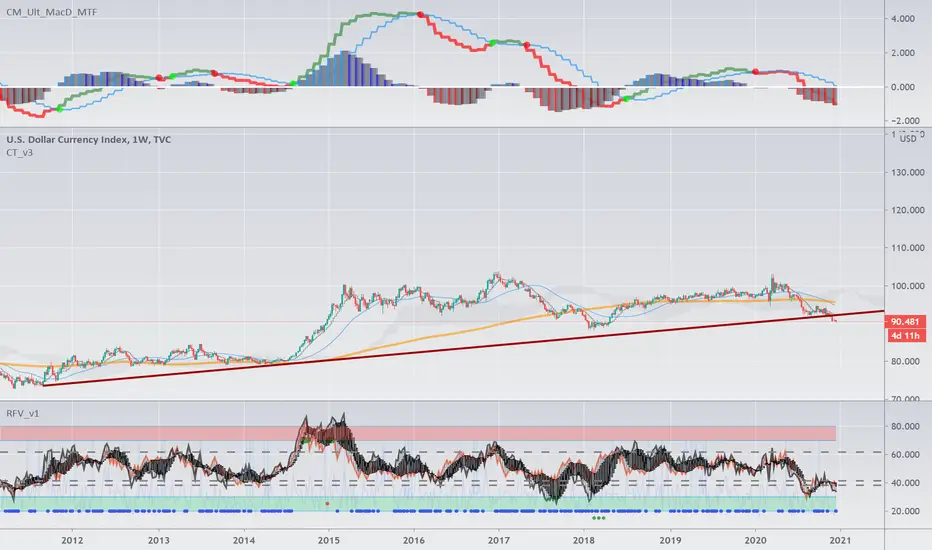OPEN-SOURCE SCRIPT
מעודכן RSI & RVI

Relative Volatility vs Relative Strength
הערות שחרור
Added tie in to Put to Call Ratio for Signal generation.The P:C signals are designed for broad market bullish bias.
Small green dots on the bottom indicate oversold with a low RSI.
Small blue dots on the bottom indicate a neutral market state.
Small red dots on the bottom indicate a medium-high to high RSI with an excessively bullish option outlook.
These added indications, if your ticker is correlated to the broader market should assist in noting bottoms on the hourly chart with green dots.
Small red dots should assist with profit taking and not be used to short the market, the general pattern should be buy during green, lighten to runners during blue and take profit on the rest of the runner if red shows up.
הערות שחרור
Functionality Update- Relative Strength (RSI) - Black Line
- Relative Volatility (RVI) - Orange Line
- Intra-trend levels added - 38.2, 41.4, 61.8
- Candle Body - Defined OHLC (RSI simple moving average, RSI, RVI, RVI simple moving average)
Since volatility is relative to trend when trending bullishly volatility is to the downside. Conversely, volatility is to the upside when trending bearishly. RVI uses RSI's trend to determine which activity direction is considered volatility.
RVI rests on the counter-trend side of RSI. Its return inside of the candle body signifies a possible trend continuation. RSI similarly is considered to be breaking out once it leaves the candle body, and the trend weakening when inside.
The intra-trend levels are to help increase the useful resolution of the RSI chart. In a typically bullish trend, RSI will often dip into the 38.2-41.4 area and set a higher low. In a typically bearish trend, tops will often run out of steam near 61.8 rather than going all the way to 80+ overbought.
The candle body is actually just 7 SMAs of RSI and RVI but to help differentiate their purpose they are displayed this way so that RSI being inside of the SMAs indicates that the market in the short term is basically balanced or balancing, and being outside of them is a state of excess; essentially just saying that the market is moving. I use this in combination with Ichimoku's equilibrium concept so that RSI returning inside of the candle can help in the determination that a retrace in the middle of a trend move is a return to a 'relative fair value' and bounce back out signifys a continuation.
סקריפט קוד פתוח
ברוח האמיתית של TradingView, יוצר הסקריפט הזה הפך אותו לקוד פתוח, כך שסוחרים יוכלו לעיין בו ולאמת את פעולתו. כל הכבוד למחבר! אמנם ניתן להשתמש בו בחינם, אך זכור כי פרסום חוזר של הקוד כפוף ל־כללי הבית שלנו.
כתב ויתור
המידע והפרסומים אינם מיועדים להיות, ואינם מהווים, ייעוץ או המלצה פיננסית, השקעתית, מסחרית או מכל סוג אחר המסופקת או מאושרת על ידי TradingView. קרא עוד ב־תנאי השימוש.
סקריפט קוד פתוח
ברוח האמיתית של TradingView, יוצר הסקריפט הזה הפך אותו לקוד פתוח, כך שסוחרים יוכלו לעיין בו ולאמת את פעולתו. כל הכבוד למחבר! אמנם ניתן להשתמש בו בחינם, אך זכור כי פרסום חוזר של הקוד כפוף ל־כללי הבית שלנו.
כתב ויתור
המידע והפרסומים אינם מיועדים להיות, ואינם מהווים, ייעוץ או המלצה פיננסית, השקעתית, מסחרית או מכל סוג אחר המסופקת או מאושרת על ידי TradingView. קרא עוד ב־תנאי השימוש.